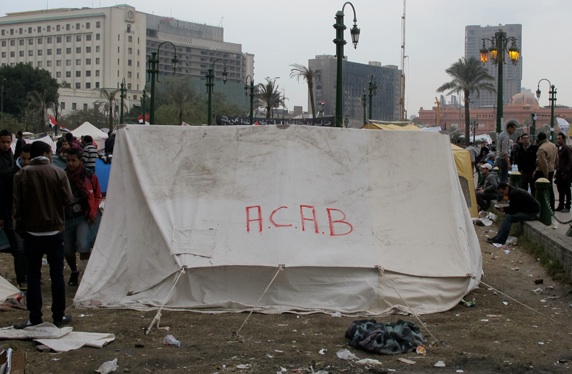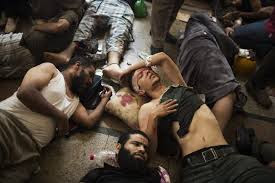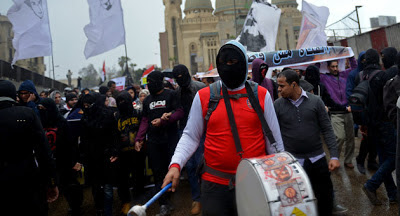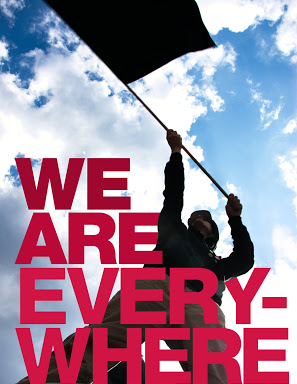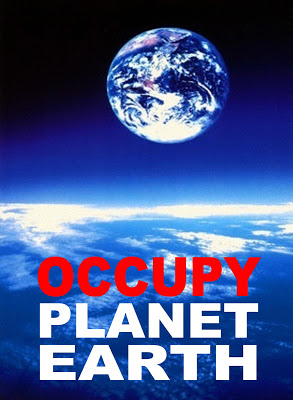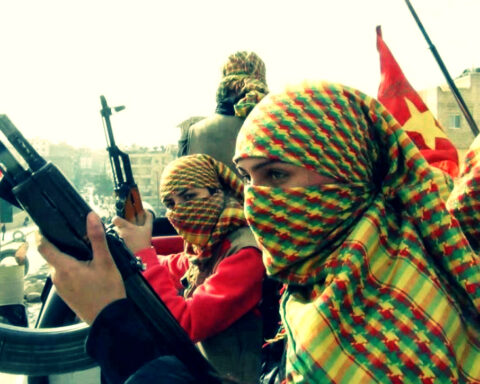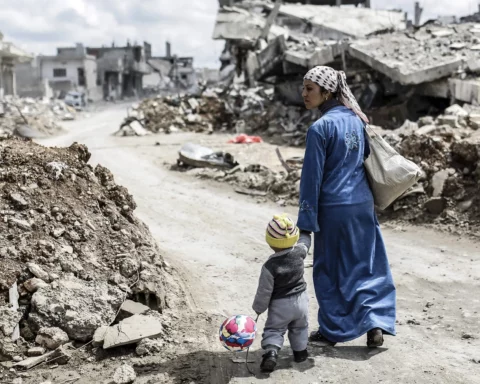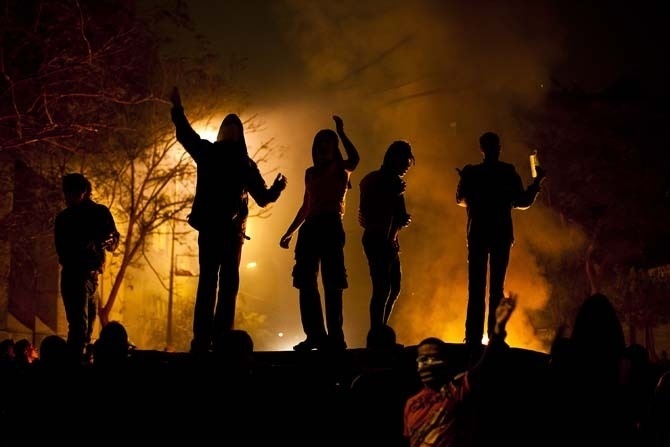
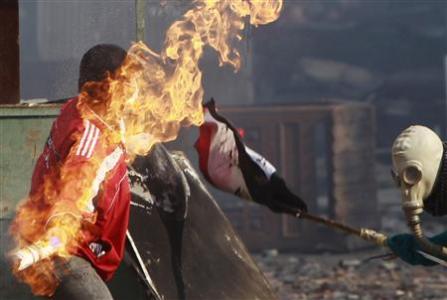
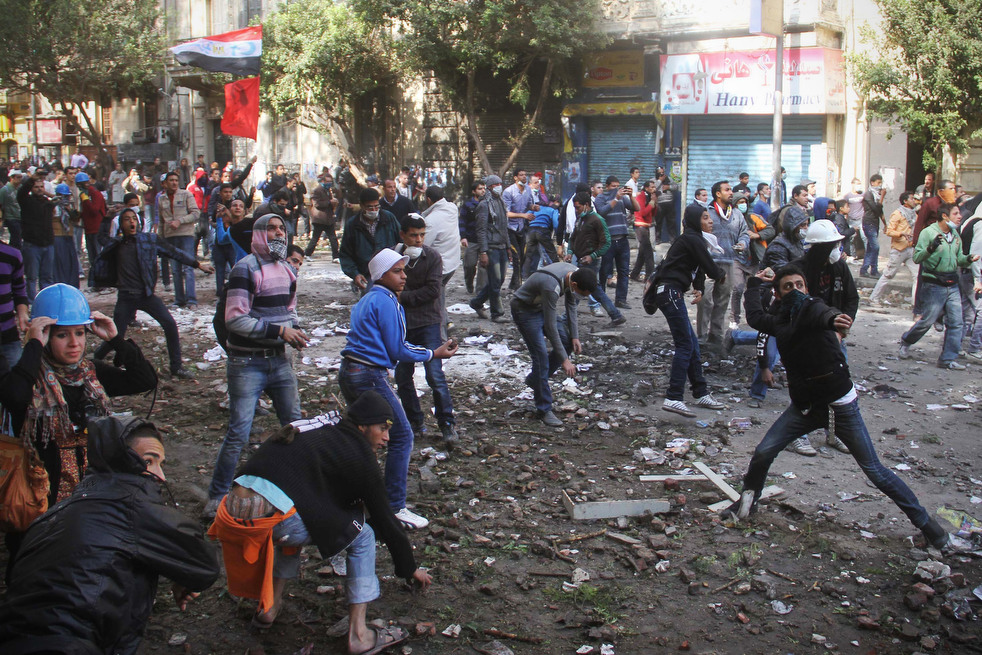
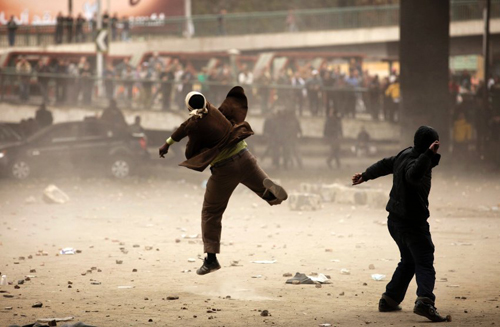
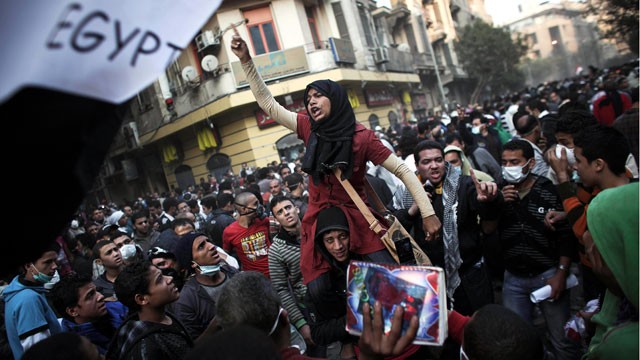
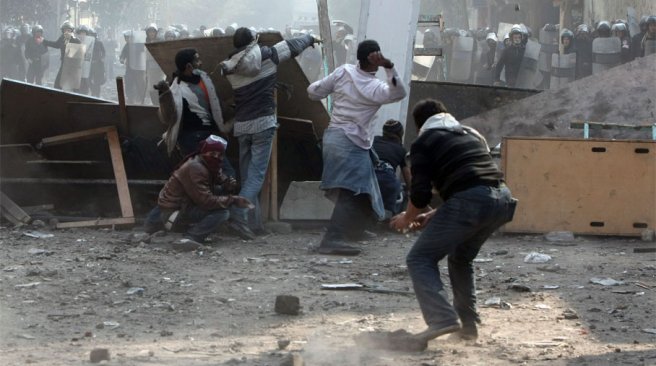
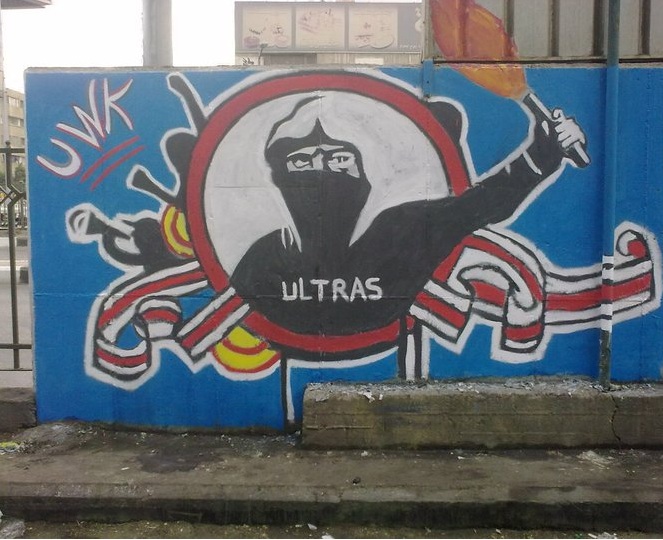
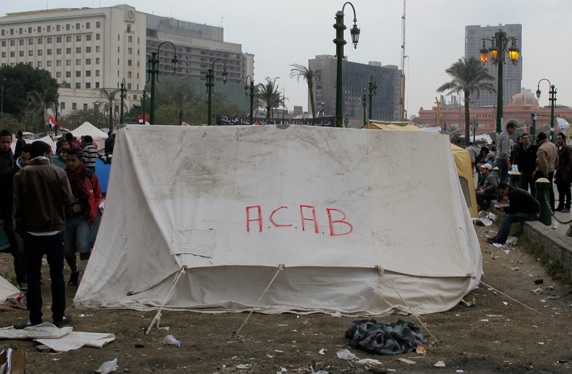
“A beautiful storm has come, but not yet the beautiful destruction”. The cyclone of intifada continues to destroy the Egyptian state, “I am boycotting because I believe it is a circus,” said rebel-blogger Hossam el-Hamalawy, “You cannot have clean elections while the police force which has not been purged is in charge of securing the ballot boxes. You have to settle the battle in the streets, then you settle it in the ballot boxes. We have to win our occupation in Tahrir Square first.”
The street opens itself to the community-in-motion as a parallel space against the state from which the emergent counter-power reproduces new ways of thinking and acting.
The battle of Tahrir is diffused throughout society this last year. Escaping reification into the political apparatus of capture, it exists as a Popular Power in the Streets. Over the last week it has manifest as violent insurrection in the district surrounding Tahrir Square, the Muhammad Mahoud meidan, where I stayed months ago:
“The people in Muhammad Mahmoud are decidedly not revolutionaries, they are vandals,” a police captain insisted. When in Rome, do as the Vandals.
From the revolution to civil war- no longer revolutionaries but a new form of life escaping from the structures of civilization. “It’s a way of life. You don’t just become one. You aren’t converted. You have to be an Ultra from within,” said Ahmed, a Cairo native and Ultra member who only agreed to an interview if his real name and appearance were not revealed. The Ultras are “anti-media,” according to Ahmed. He said they prefer to keep their identities secret.
‘Ultra’. Who the fuck are these guys. “The Ultras have stood at the forefront of recent clashes with security forces. In many cases, they were armed with rocks, petrol bombs and firecrackers.” A fraternal organization of mad bombers.
“The Ultras are here. I know that because they’re the only ones facing the CSF (police) with force while singing their hymns,” protester Mosa’ab Elshamy wrote on Twitter on the first day of last weeks clashes. It is part of the Ultras code to remain anonymous to non-members. Dressed in a uniform of skinny jeans, neck scarves and hooded sweatshirts pulled tight over their heads, the Ultras in Tahrir could go unnoticed.
They are here now. Stepping out from the blaze of their flares. Constitutive of the ongoing occupation, their camp is set apart by hastily sketched graffiti on the tents that proclaims their beliefs for those who know the code.
“A-C-A-B,” Ahmed said, reading aloud the red etchings on the outside of his tent. “All cops are bastards,” he explained. According to Ahmed, the abbreviation is a motto for Ultras clubs around the world. Ultra clubs, and the rest of us.
According to the blog, The Turbulent World of Middle East Soccer:
“Established in 2007, the ultras — modelled on Italy’s autonomous, often violent fan clubs – have since proven their metal in past confrontations with the Egyptian police, who charge that criminals and terrorists populate their ranks.
The ultras key role in the rebellion extends a tradition of soccer’s close association with politics in Egypt dating back to when the then British colonial power introduced the game to the North African country in the early 20th century. “
Out of the scene and into the streets! “Before the revolution the Ultras were confined to stadiums, so people didn’t know much about them,” occupier Elshamy said.
“After the revolution a lot of perspectives changed about them and they became really popular. They were described as those courageous guys. They stayed there in the square almost through 100 hours of fighting; It’s easy to notice them because of their use of Molotov cocktails, their extreme courage and recklessness, their chants. They became a common sight.”
Says an El Ahly ultra: “You don’t change things in Egypt talking about politics. We’re not political, the government knows that and has to deal with us,”
Rabab El-Mahdi calls this “clear class confrontations”. “Since the Ultras were created, they were always targeted by state security. They are seen as a mob or as hooligans,” she continues, “So they developed skills that none of the middle class was forced to develop. Plus they come from backgrounds where such skills are needed on daily basis just as survival mechanisms.”
She added that as long as Egypt’s security apparatus remained intact, violent confrontations would continue. “The skills they developed in dealing with police came in very handy and it comes in handy every time there is a direct confrontation,”
The ultras’ experience is also reflected in the setting up of survival services for the mass of protesters camped on the square in tents behind barricades and the introduction of a rotation of labour among them.
“There were designated rock hurlers, specialists in turning over and torching vehicles for defensive purposes and a machine like quartermaster crew delivering projectiles like clockwork on a cardboard platters.”
Ultras member Ahmed is careful to explain that he and his “brothers in blood” do not attack first. “An Ultra doesn’t attack anyone, We’re a watchdog for the truth. Any unfairness that we spot, within the state or anywhere, we have to stand up for what is right.”
“We don’t have any political direction. Whenever we go to a strike or a demonstration, we do it on an individual basis. We don’t announce it. We are just here as humans. On Saturday, initially we came individually. But then we found because we have similar beliefs we went straight to the front line and there were our brothers to the left and right. The personality of an Ultra places you at the front line because you are defending a cause. There is nothing easy in life, we have to suffer and sacrifice until we achieve.”
While ultras’ Power-Knowledge helped substantially in articulating and holding the front line, the front line was made of many other youths who carried on the fight. Some were young Islamists, refusing to obey their official party line. But the majority of front line fighters came from the substantial population of young, socially excluded men from Cairo’s peripheral ‘ashwa’i [“informal”] neighbourhoods. They are sometimes called the wilad sis.
The wilad sis are young working class men who might be described as precarious workers, most are unemployed, underemployed, unskilled and semi-skilled, doing occasional jobs that change every day (though on most days, there is no “work”). Others refuse work and subsist upon the black market. They are often marked by a particular dress code and hairstyle that often involves copious quantities of gel (the word sis alludes to the attention they often pay to their appearance).
Earlier this year I traveled through Tunisia, Cairo and in Alexandria I met, over much hash, with a group of young insurgents who identified themselves as ‘Franco Arabia’s’. They celebrated a pan- Mediterranean, as expressed in a unique style of hip-hop and aggressive migration to Italy, a proclivity towards anarchism, queer liberation and are combatively against patriarchy
Proudly they told me it was their call for a day of action against the police- who had killed one of their comrades, which helped instigate the insurrection. The day of action was organized for Jan 25th– the national day of police, and after its announcement on face book, Tunisia exploded and the antagonisms in Alexandria and across Egypt did as well, until finally on that day, the demonstration led millions onto the streets which they violently held for weeks.
From the various field reports that I salvaged these quotes from, there is recognition of the middle class activists (as well as Islamist youths), most who expressed the understanding that without the barricades and violent resistance they would not have been able to protest. But no interviews for this montage. I will though, share this observation from Lucie Ryzova, an engaged-blogger during this last battle:
“It is in Abdeen, the streets east of Tahrir Square between Muhammad Mahmoud Street and Meidan Bab al-Luq, leading to the ministry of interior, where a battle was waged during the past week.
And a battle it was. People went there knowing what they were getting into. They went there to fight. Police threw teargas canisters and used shotguns (occasionally also live ammunition); against them was a line of young men mostly throwing stones, but also Molotov cocktails and small homemade bombs.
It was a “battle for the dakhiliyya [‘the Ministry of Interior’]“, but that does not mean that any of the young men facing the police necessarily wanted or intended to take over the ministry’s building. It was a symbolic battle – or more precisely, a frighteningly real and bloody fight over a symbolic location; the fight itself was the message.
The khatt al-nar [“firing line”] belonged to particular people who went there to beat and get beaten. Throughout the first week of the Second Revolution, Tahrir Square and the battlezone to its east each had its own demographic.
Each was a different crowd, but they can only be understood as a symbiosis – a specific social alliance – as both constructed and supported each other, and they increasingly overlapped. The square, the “safe” zone, contained a truly socially mixed crowd. People from all walks of life came there, often several times a day, in support of those who decided to camp out, to help “hold” the square and support its cause.
One saw a social mix rarely seen in Egypt (though it was famously present in the First Revolution): middle-class men and women, some of them activists but most of them not; young and old, in suits, kefiyehs and jeans, alongside the galabiyas and long beards of the salafis; bareheaded women as well as munaqqabat (fully veiled women).
On the front line, by contrast (and naturally so given the nature of the battle), the demographic was predominantly (though not exclusively) young male and socially marginal.
But the frontline and the Meidan are also part of one whole. The frontline’s position is to protect the Meidan, even if it also developed into a fight for its own sake. Without the on-the-ground crowd of ultras and the wilad sis prepared to stop police violence with their own bodies, and most importantly, to hit back, the largely middle-class opposition could not have held the Meidan for long.”
Was this violent defence not also the case for Occupy Vancouver? As made clear by Zig-Zag, it was the fear of the chaos brought forth in the 2011 riots that forced the city to keep their pigs on a leash. Anyone who was present at both riot and occupation know the difference was not only the communication of destruction- but also the communication of Counter Power.
The insurrections last year that has created this global intifada, was the becoming of a new solidarity between the pro-revolutionary’s and the rioting hoodlums. Such commonality was developed over years of relationships initiated by a militant underground group in Tunisia called Takriz, (its closest translations is, ‘breaking my balls’ or ‘bollocks to that’)
Realizing the advantage in working with Ultras as opposed to the same-old leftist shit- over several seasons they developed a Web forum for Ultras from different teams, hosted by Takriz. This allowed for years of mutual agitation, so that come the rupture is was a lightning transition from riot to insurrection
The ultras were also on Egypt’s streets at first crack. On January 24, the day before thousands planned to protest the Mubarak regime, the Ultra Facebook pages sent out a message saying, “We’re not political, we’re not part of this as an organization—you as individuals are free to do whatever you want (…) This is what we’ve been preparing for.”
There were also e-mails with attachments describing how to deal with the military—”an Ultra thing from Tunisia,” remembers Kotb Hassaneen, an Alexandrian insurgent. Some of the tactics they shared, says Foetus, the codename for a member of Takriz, “have roots in long-standing contacts with anarchist and international protest groups like Indymedia, the Antifascist Network, and CrimethInc. For example, the technique called “Black Bloc”—having protesters wear black clothing en masse for impact and anonymity, with padding and protection to reduce injuries—dates back to 1980 in Germany.”
Here, the potentiality of a becoming-together of the spirit of the Riot and the antagonisms of the Occupation remain an open chance for us- in this Global Intifada.
The cyclones of struggle blast this world apart. Although there are periods that the state of siege regains the social peace- any moment that will explode, and again the streets will fill with fire. In this epoch we cannot allow the memory of the dead to be stolen. We stand as the Mothers of the martyrs who hold vigil in the midst of street battles.
Over the last year the insurrection has not ceased in Egypt or Tunisia, overcoming the billions of dollars empire spends (Canada $20 million) on counter-insurgency- in the form on elections and ‘democratic-institution building’. This apparatus of capture is the same network of regulation we battle here. The institutionalization of crisis is best dealt with by the methods deployed throughout the ‘Arab spring’- that is, the absolute destruction of institutions and the armed exodus from the reifying radiation left in their wake. In Tunisia and Egypt I was witness to the ‘fired’ shells of bureaucratic control. The revolted will not trade in their looted weapons (93 cop shops and over 300 military barracks sacked in Egypt alone) for the opportunity to vote. And they have not abandoned the struggle against imperial democracy.
Almost everyone I met over there, I asked, ‘what will you do when the state steals your revolution?’ The unanimous response was, ‘We will just have another one’! Last month in Sidi Bouzid, the town from where the uprising in Tunisia began, the multitude set fire to the headquarters of the winning political party, the day after the election. Such will the beautiful destruction be wrought.
d.
Links to my travel writing & chronology of insurrections in Tunisia and Egypt:
http://momentofinsurrection.wordpress.com/fragments-of-intifada-in-tunis-egypt/
http://momentofinsurrection.wordpress.com/chronolgy-of-intifada-in-tunisia-egypt/
